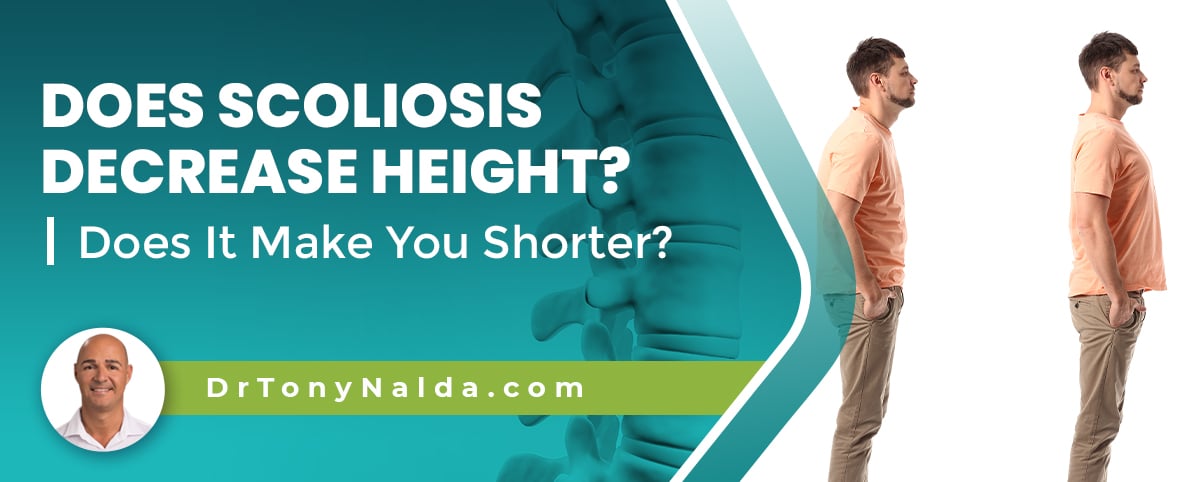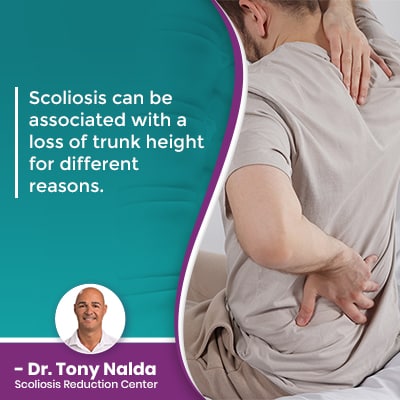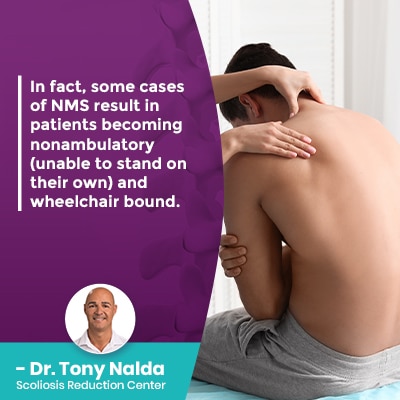Does Scoliosis Decrease Height? Does It Make You Shorter?

Scoliosis introduces a lot of uneven forces to the body, which is why its effects aren’t just isolated to the back; the condition can disrupt a person’s overall symmetry and can also lead to a loss of height. The more severe a condition, and the longer it’s left untreated, the more likely it is to cause a loss of trunk height.
As a structural spinal condition, scoliosis can affect the body in numerous ways, from postural deviation to back pain and a loss of height. For people with an unnatural spinal curve, it can be difficult to stand fully erect, and this is more related to the health of the spine than bad posture.
The health of the spine is important in a number of ways, so let’s start with the many roles the spine plays in maintaining overall health.
Table of Contents
How Important is Spinal Health?
The spine plays some key roles in how the body moves, thinks, and functions; not only does the spine provide the body with structure and facilitate its ability to stand upright and practice good posture, it helps protect important organs and partners with the brain to form the body’s central nervous system (CNS).
The central nervous system is a complex communication network that involves the sending and receiving of signals/messages between the brain and the rest of the body, so in terms of communication, the spine is involved in the function of virtually every working system within the body.
Healthy Spinal Curves
The spine is naturally curved at each of its main sections: cervical spine (neck), thoracic spine (middle/upper back), and the lumbar spine (lower back).
The spine’s natural and healthy curves make it more flexible, better able to absorb mechanical stress during activity, and stronger, like a coiled spring.
If the spine’s natural curves are in place, this means the vertebrae (bones of the spine) are in alignment as they’re stacked on top of one another.
If one or more vertebrae shift out of alignment with the rest of the spine, which can happen for a variety of reasons, the spine is no longer aligned, and this impacts its ability to function optimally as its biomechanics are disrupted.
Scoliosis involves the development of an unnatural lateral (side-to-side) curvature of the spine that also rotates (twists), and has a minimum Cobb angle measurement of 10 degrees.
A patient’s Cobb angle is a key piece of information when it comes to how severe a patient’s condition is, so let’s take a closer look at what it indicates, and how the different levels affect the body, including how scoliosis can affect a person’s height.
Condition Severity
When scoliosis is first diagnosed, the process involves further classifying conditions based on important patient/condition variables, and one of those is condition severity.
As mentioned, condition severity is determined by a measurement known as Cobb angle, and this is taken during X-ray by drawing lines from the tops and bottoms of the curve’s most-tilted vertebrae, at the apex of the curve.
The intersecting lines drawn form an angle that’s expressed in degrees. The higher a patient’s Cobb angle, the more out of alignment the spine is, the more severe the condition, and the more likely it is to cause a loss of height and a number of other symptoms/effects:
Mild scoliosis: Cobb angle measurement of between 10 and 25 degrees
Moderate scoliosis: Cobb angle measurement of between 25 and 40 degrees
Severe scoliosis: Cobb angle measurement of 40+ degrees
Very-severe scoliosis: Cobb angle measurement of 80+ degrees
Another key feature of scoliosis is that it’s progressive in nature, meaning it’s virtually guaranteed to worsen over time, particularly if left untreated, or not treated proactively.
So where a scoliosis is at the time of diagnosis isn’t necessarily indicative of where it’s going to stay; only proactive treatment can work towards counteracting the condition’s progressive nature.
Now, let’s directly address how scoliosis can affect a person’s height.
Scoliosis and Height
In many cases of mild scoliosis, height is unlikely to be affected because the condition’s symptoms are also mild, even to the point of only an expert being able to notice the subtle early indicators of scoliosis, especially in children for whom the condition is not compressive.
Compression is the main cause of condition-related pain as the spine and its surrounding muscles and nerves feel the effects of uneven pressure.
Scoliosis becomes compressive once skeletal maturity has been reached, which is why pain is the number one symptom in adults, while postural deviation is the main symptom in children and adolescents.
 Scoliosis can be associated with a loss of trunk height for different reasons.
Scoliosis can be associated with a loss of trunk height for different reasons.
If scoliosis has caused a lot of postural changes that disrupt the body’s overall symmetry, such as uneven shoulders, hips, the development of a rib arch, etc., these types of changes can cause a prominent lean to one side; if a person is leaning to the side, they’re not standing fully erect, so loss of height can occur that way.
In addition, due to the condition’s uneven forces, it can also affect the spine’s intervertebral discs, which are key structures when it comes to maintaining spinal health.
Intervertebral Discs
We talked earlier about the spine’s basic structure, in terms of its curves and alignment, but the spinal discs deserve their own mention as they facilitate spinal health and function in multiple ways, which is also why they are generally the first spinal structures to show the effects of degeneration.
Between adjacent vertebrae, there is an intervertebral disc, consisting of two parts: a soft inner gel-like nucleus and a tough and durable outer annulus.
The discs provide the spine with structure (adjacent vertebrae attach to the disc in between), added flexibility and range of motion, cushioning so adjacent vertebrae don’t rub up against each other causing friction and degeneration, and act as the spine’s shock absorbers.
Disc Degeneration
Oftentimes, in scoliosis patients, because the spine is unnaturally curved, affecting its overall health, the discs feel the effects and start to deteriorate earlier than in people whose spines are healthy and able to maintain natural spinal curves and alignment.
When a disc starts to deteriorate, it tends to lose height, change shape, and become desiccated.
When this happens, the structure of the spine is affected, including its ability to be fully extended vertically, meaning people can experience a loss of vertical trunk height to varying degrees.
In addition, there are also different types of scoliosis to consider, some that tend to affect height more than others.
Different Types of Scoliosis
Another aspect of further classifying scoliosis at the time of diagnosis is based on condition type, determined by its causation, so let’s briefly explore the different types, with a focus on those that are most closely associated with a loss of height.
The main type of scoliosis to affect both children and adults is what’s known as idiopathic scoliosis, and idiopathic means a condition’s causation is unknown.
Idiopathic Scoliosis
The most common type of idiopathic scoliosis is the condition’s most-prevalent form: adolescent idiopathic scoliosis, diagnosed between the ages of 10 and 18.
For this age group, it’s difficult to monitor precisely how much height is affected because growth is constantly occurring, and treatment works towards counteracting progression as growth and development is the condition’s main trigger for progression.
As the effect of scoliosis on height is difficult to monitor in young patients who are still growing, let’s move on to additional condition types that are more clearly associated with a loss of vertical trunk height.
Idiopathic scoliosis makes up approximately 80 percent of known diagnosed scoliosis cases, with the remaining 20 percent consisting of atypical forms with known causes: neuromuscular, congenital, and degenerative.
For our current purposes of exploring the relationship between scoliosis and height, let’s focus on neuromuscular scoliosis and degenerative scoliosis.
Neuromuscular Scoliosis
Neuromuscular scoliosis (NMS) is caused by the presence of a larger neuromuscular condition such as spina bifida, muscular dystrophy, and cerebral palsy, to name a few, and in these cases, the scoliosis develops as a secondary complication of a larger medical issue.
While not everyone with a neuromuscular condition is going to develop scoliosis, it is a common complication, and as this type has the added complexity of being caused by a neuromuscular condition that involves a disconnect between the brain and muscles/connective tissues that support the spine, these cases tend to be severe and are more likely to affect height.
 In fact, some cases of NMS result in patients becoming nonambulatory (unable to stand on their own) and wheelchair bound.
In fact, some cases of NMS result in patients becoming nonambulatory (unable to stand on their own) and wheelchair bound.
Because neuromuscular scoliosis tends to be more severe, NMS patients are at a higher risk for progression, and although being wheelchair bound isn’t exactly the same as losing actual inches of height, being unable to stand is a heigh-related factor.
In addition, for NMS patients who are wheelchair bound, the constant pressure on the spine and related muscle loss does also contribute to decreasing height over time.
Degenerative Scoliosis
Cases of degenerative scoliosis are also closely associated with a loss of height because it commonly affects adults over the age of 40 and is caused by natural age-related spinal degeneration.
As mentioned earlier, it’s most often the intervertebral discs that are the first spinal structures to show the effects of deterioration, and as one or more of the spinal discs lose height due to degenerative changes, this impacts the spine, as it looks to the discs for structure, and a number of other functions discussed earlier.
Degenerative disc disease is closely related to degenerative scoliosis, and both are closely associated with a loss of spinal height, particularly as this form is diagnosed in older adults as they age.
Conclusion
So does scoliosis decrease height? Does it make you shorter?
Scoliosis can cause a number of postural changes that involve a disruption to the body’s overall symmetry and a prominent lean to one side; this can influence a person’s ability to stand up straight and fully extend their spine.
Due to the uneven forces that scoliosis introduces to the body, it can also cause uneven wear on the spine and its individual structures, such as its intervertebral discs, and a loss of disc height can also factor into a loss of spinal height.
While it can be difficult to monitor the connection between adolescent idiopathic scoliosis and a loss of height in young patients who are constantly growing, there are other condition forms that are more clearly associated with a decrease in height.
Neuromuscular scoliosis, for one, is a severe form that can progress aggressively, to the point of causing patients to become nonambulatory, meaning they can’t stand up on their own without assistance.
In addition, for NMS patients who are wheelchair bound, the constant spinal compression caused from sitting all the time is further associated with a loss of height over time.
In cases of degenerative scoliosis, we’re talking about a condition type that affects older adults and is caused by natural age-related spinal degeneration.
Degenerative scoliosis is also likely to affect a person’s height because as the spine degenerates, this often involves a loss of disc height, impacting the spine’s structure, alignment, and overall health.
Here at the Scoliosis Reduction Center, I remind patients, who are concerned their scoliosis will make them shorter, that being proactive with treatment is the single best way to minimize the condition’s effects, including a loss of height.
Dr. Tony Nalda
DOCTOR OF CHIROPRACTIC
After receiving an undergraduate degree in psychology and his Doctorate of Chiropractic from Life University, Dr. Nalda settled in Celebration, Florida and proceeded to build one of Central Florida’s most successful chiropractic clinics.
His experience with patients suffering from scoliosis, and the confusion and frustration they faced, led him to seek a specialty in scoliosis care. In 2006 he completed his Intensive Care Certification from CLEAR Institute, a leading scoliosis educational and certification center.
About Dr. Tony Nalda
 Ready to explore scoliosis treatment? Contact Us Now
Ready to explore scoliosis treatment? Contact Us Now





